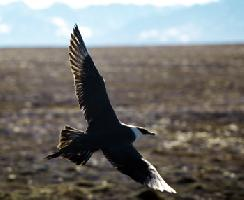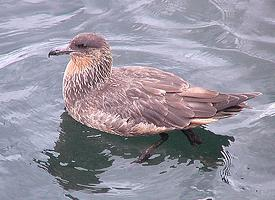
Állatleírás
The Brown Skua (Stercorarius antarcticus), often a symbol of the wild and untamed Antarctic and subantarctic regions, is a large, robust seabird that commands attention both by its presence and its behavior. With a powerful build and an imposing demeanor, this bird is an apex predator in its ecosystem, adept at both hunting and scavenging, making it a fascinating subject of study for ornithologists and bird watchers alike.Physical Description:
The Brown Skua is notable for its considerable size, typically reaching lengths of 50 to 58 cm (20 to 23 inches) and wingspans that span approximately 125 to 140 cm (49 to 55 inches). It possesses a hefty body, long, broad wings, and a fairly long tail that can appear wedge-shaped in flight. The plumage of the Brown Skua is predominantly dark brown, with lighter shades and sometimes streaks on the head, neck, and underparts, which can vary among individuals. Its powerful legs and feet are webbed, aiding in its ability to swim, while its sharp, hooked beak is perfectly adapted for tearing flesh, indicative of its predatory and scavenging habits.
Behavior and Diet:
Brown Skuas are known for their aggressive nature, especially when feeding or defending their territory. They are opportunistic feeders, preying on a wide range of foods. Their diet includes fish, small birds, and carrion, but they are perhaps most notorious for their attacks on other seabirds. They are skilled hunters, often chasing down and overpowering other birds to steal their catch or to consume them directly. During the breeding season, they can be particularly bold, targeting the eggs and chicks of other seabirds, including penguins. Brown Skuas have also been observed following fishing boats and scavenging waste, demonstrating their adaptability and opportunistic nature.
Reproduction and Lifecycle:
The breeding season of the Brown Skua is closely tied to the Antarctic summer, typically nesting in solitary pairs scattered across the subantarctic islands and parts of the Antarctic Peninsula. They are ground nesters, with nests made of grass, moss, and feathers. The female usually lays one to two eggs, which are incubated by both parents for about a month. The chicks are altricial at birth, requiring several weeks of parental care before they are ready to fledge. The Brown Skua exhibits strong site fidelity, with pairs often returning to the same nesting site year after year.
Conservation Status:
Currently, the Brown Skua is not considered to be at immediate risk of extinction and is classified as Least Concern by the International Union for Conservation of Nature (IUCN). However, like many species, they face threats from climate change, pollution, and changes in their food availability due to overfishing and shifts in marine ecosystems. Conservation efforts and ongoing research are essential to ensure that these impressive birds continue to thrive in their remote and wild habitats.
In conclusion, the Brown Skua is a formidable presence in the southern oceans, embodying the raw and untamed spirit of the Antarctic. Its adaptability, combined with its fierce predatory behavior, makes it a key species in its ecosystem, playing important roles as both predator and scavenger. For those lucky enough to observe these birds in their natural habitat, the Brown Skua offers a captivating glimpse into the complex dynamics of nature's most remote environments.
Hasonló állatok
Új állatfotók
Top 10 állat
- Dolphin gull (Leucophaeus scoresbii)
- Diana monkey (Cercopithecus diana)
- Japanese macaque (Macaca fuscata)
- Galápagos tortoise (Geochelone nigra complex)
- Stone loach (Barbatula barbatula)
- Moustached guenon (Cercopithecus cephus)
- Russian tortoise (Testudo horsfieldii)
- Common house mosquito (Culex pipiens)
- Japanese spider crab (Macrocheira kaempferi)
- Giant peacock moth (Saturnia pyri)


